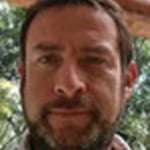
Luis Vinueza
Luis arrived in the Galápagos Islands for the first time when he was 11 years old in 1983, and from that time on he knew that Galápagos would one day be his home. He returned to the islands in 1995 and spent 14 months camping in a tent. Seven of those months were spent on Española Island, studying the relationship of reproductive success and mate retention of Nazca boobies. In 1997, he started working for the marine lab at the Charles Darwin Research Station (CDRS) on different fields including diving surveys to assess the patterns of marine biodiversity around the Galápagos Marine Reserve. His research included counting lobsters and sea cucumbers and participating as an advisor for CDRS during the negotiation process that led to the 1998 creation of the Galápagos Marine Reserve.
In 2002, he earned an MSc. in marine environmental protection at the University of Wales in Bangor, U.K. In 2009, he received a Ph.D. in marine ecology at Oregon State University with the support of a Fulbright Scholarship, studying the impacts of environmental variation on the ecological role of marine iguanas. From 2010 to 2017, Luis taught marine ecosystem-based management and techniques of marine research at the Universidad San Francisco de Quito.
He decided to become a naturalist guide to expand his understanding of Galápagos, and contribute to the conservation of this unique archipelago by creating awareness of the environmental issues that affect the islands.
